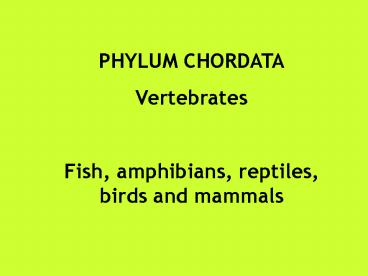PHYLUM CHORDATA - PowerPoint PPT Presentation
1 / 39
Title:
PHYLUM CHORDATA
Description:
PHYLUM CHORDATA Vertebrates Fish, amphibians, reptiles, birds and mammals CLASS OSTEICHTHYES EX: tuna, bass, bluegill, seahorse Bony fish Jaws Paired fins Bony ... – PowerPoint PPT presentation
Number of Views:210
Avg rating:3.0/5.0
Title: PHYLUM CHORDATA
1
PHYLUM CHORDATA Vertebrates Fish, amphibians,
reptiles, birds and mammals
2
GENERAL TRAITS OF CHORDATES
- Bilateral symmetry
- Complete digestive system
- Closed circulation with a ventral heart
- Dioecious
3
- These traits present during some part/stage in
their life - a. Notochord- becomes spine
- b. Dorsal nerve cord- becomes spinal cord
- c. Pharyngeal gill slits
- d. tail
4
GENERAL TRAITS OF FISH 1. Streamlined
bodies 2. Mucus covered bodies 3. Paired fins
help with steering balance. 4. Maintain
buoyancy 5. tissues bones not as heavy
5
- 6. Respiration- gills water enters mouth,
passes over gills , gases exchange, water leaves
w/CO2 thru gill slits. - 7. Circulation- 2 chambered heart
- a. 1 atrium 1 ventricle
- Path of Blood
- body-atrium-ventricle-afferent
arteries-gills-efferent arteries-body
6
- 8. Nervous- brain spinal cord
- 9. Sensory-
- a. Good sense of smell
- b. Poor eyesight
- c. Lateral Line System- sensory pits in skin
attached to fluid filled canals under skin can
detect movement.
7
- Excretory System- 2 kidneys
- Osmoregulation- regulation of water ions (salt)
in body. - Freshwater fish- water moves into blood due to
osmosis urinate a lot to remove excess water - Saltwater fish- water moves out of blood into
salty water urinate very little to retain water.
8
- Digestive System-
- Teeth- modified scales for grasping prey
- Swallow prey whole or in large chunks.
- Large stomach for storing infrequent meals.
9
THREE CLASSES OF FISH
10
- CLASS AGNATHA
- EX hagfish lamprey
- Jawless fish w/smooth skin- no scales
- No paired fins
- Cartilage skeleton
- Gills open to water
- Fertilization- external
- Oviparous- lays eggs externally
11
- Lamprey-
- a. Suckerlike mouth
- b. Teeth rasping tongue scrape scales off
host. - c. Suck blood of fish
12
(No Transcript)
13
- Hagfish-
- a. Live buried in sand mud
- b. Mouth with 4 pairs of tentacles
- c. Enter dying/dead fish thru mouth
- d. Eat contents of body, leaving sack of skin
bones - e. Secretes green slimy mucus to deter predators
14
(No Transcript)
15
- CLASS CHONDRICHTHYES
- EX sharks, skates, rays
- jaws
- Paired fins
- Cartilage skeleton
- Gills open to water- gill slits
- Dermal placoid scales- dermal denticles
- a. Point backward- reduces friction in water
- b. feels like and used to be used as sandpaper.
- 7. Buoyancy- oily livers
16
(No Transcript)
17
8. Special Digestive Adaptations a. Teeth in
rows 1. ratchet forward when one is lost. 2.
New row of teeth develop every 7-8 days b.
Rugae- folds in stomach that expand to hold
large meals c. Spiral valve- increases
absorption of nutrients (like human villi)
18
9. Special Respiratory Adaptations a. Ram
Ventilation- some sharks 1. Swim with mouth
open to force water into mouth over gills.
19
b. Spiracles- holes behind eyes 1. Used for
breathing while eating.
20
LABEL THE DIAGRAM OF THE EXTERNAL
21
10. Special Sensory Adaptations a. Lateral
Line system b. Ampullae of Lorenzini- 1.
pits in snout that detect impulses or electrical
currents in water. 2. Used to find
prey, mates, identify predators. 3.
Helps sense in murky or turbulent water
22
(No Transcript)
23
11. Fertilization- internal a. Males have
penis- like structure called clasper for
inseminating female.
24
- b. Development of eggs
- 1. Oviparous- lays eggs
- 2. Ovoviviparous- eggs hatch inside mother
- No placenta so babies that have hatched sometimes
eat other eggs /or siblings that have hatched. - EX Great whites nurse sharks
- 3. Viviparous- Pups are attached to mother by
placenta - 1. EX bull shark, mako, whale shark,
hammerheads
25
12. Smallest- dogfish shark (1 meter) 13.
Largest- whale shark (10 meters filter feeds)
26
14. Skates rays find food along bottom.
27
(No Transcript)
28
(No Transcript)
29
Male shark
Female shark
30
(No Transcript)
31
(No Transcript)
32
(No Transcript)
33
(No Transcript)
34
- CLASS OSTEICHTHYES
- EX tuna, bass, bluegill, seahorse
- Bony fish
- Jaws
- Paired fins
- Bony skeletons
- Gill openings covered with operculum- muscular
plate that pulls water into mouth.
35
- Buoyancy- swim bladder
- a. Increase air- fish rises
- b. Decrease air- fish sinks
- Special Sensory Adaptations
- a. Ossicles- pick up vibrations in water for
hearing
36
- Reproduction
- a. Fertilization- external
- b. Oviparous
- c. Males create nest. Females lay eggs.
Males fertilizes eggs. Sometimes female
protects eggs until hatching. - d. Spawning- return to river born in to
reproduce (salmon)
37
10. Scales- a. Can be used to identify
fish b. Can estimate age of fish with rings
(annuli) on scales. 1. Cosmoid 2.
Ganoid 3. Cycloid 4. Ctenoid
38
Pay close attention to these pictures so that
when you are dissecting the shark you recognize
organs! You will label a picture of the internal
anatomy of the shark at the end of these notes!
39
- Shark skin was once used for
- a. Sand paper b. Clothing c. Writing
utensils - Bony fish belong to the class
- a. Agnatha b. Chondrichthyes c. osteichthyes
- Sharks reproduce using ___ fertilization
- a. External b. internal
- Which type of fish has placoid scales?
- a. Bass b. Stingray c. hagfish
- The structure in bony fish that maintains
buoyancy is - a. Operculum b. Swim bladder c. Oily liver































